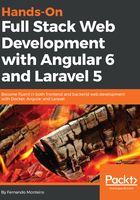
Understanding the Core Concepts of Laravel 5
As the title of this chapter suggests, we will be providing a general overview of the Laravel framework, covering the main concepts related to the development of web applications using a web services architecture. More precisely, we will use a RESTful architecture in this book.
We assume that you already have a basic understanding of the RESTful architecture and how web services (here, we call them Application Programming Interface (API) endpoints) work.
However, if you are new in this concept, don't worry. We will help you get started.
The Laravel framework will be a helpful tool because with it, all of the data inside our controllers will be converted to the JSON format, by default.
The Laravel framework is a powerful tool for the development of web applications, using the paradigm convention over configuration. Out of the box, Laravel has all of the features that we need to build modern web applications, using the Model View Controller (MVC). Also, the Laravel framework is one of the most popular PHP frameworks for developing web applications today.
From now until the end of this book, we will refer to the Laravel framework simply as Laravel.
The Laravel ecosystem is absolutely incredible. Tools such as Homestead, Valet, Lumen, and Spark further enrich the experience of web software development using PHP.
There are many ways to start developing web applications using Laravel, meaning that there are many ways to configure your local environment or your production server. This chapter does not favor any specific way; we understand that each developer has his or her own preferences, acquired over time.
Regardless of your preferences for tools, servers, virtual machines, databases, and so on, we will focus on the main concepts, and we will not assume that a certain way is right or wrong. This first chapter is just to illustrate the main concepts and the actions that need to be performed.
Keep in mind that regardless of the methods you choose (using Homestead, WAMP, MAMP, or Docker), Laravel has some dependencies (or server requirements) that are extremely necessary for the development of web applications.
In this chapter, we will cover the following points:
- Setting up the environment
- The basic architecture of a Laravel application
- The Laravel application life cycle
- Artisan CLI
- MVC and routes
- Connecting with the database